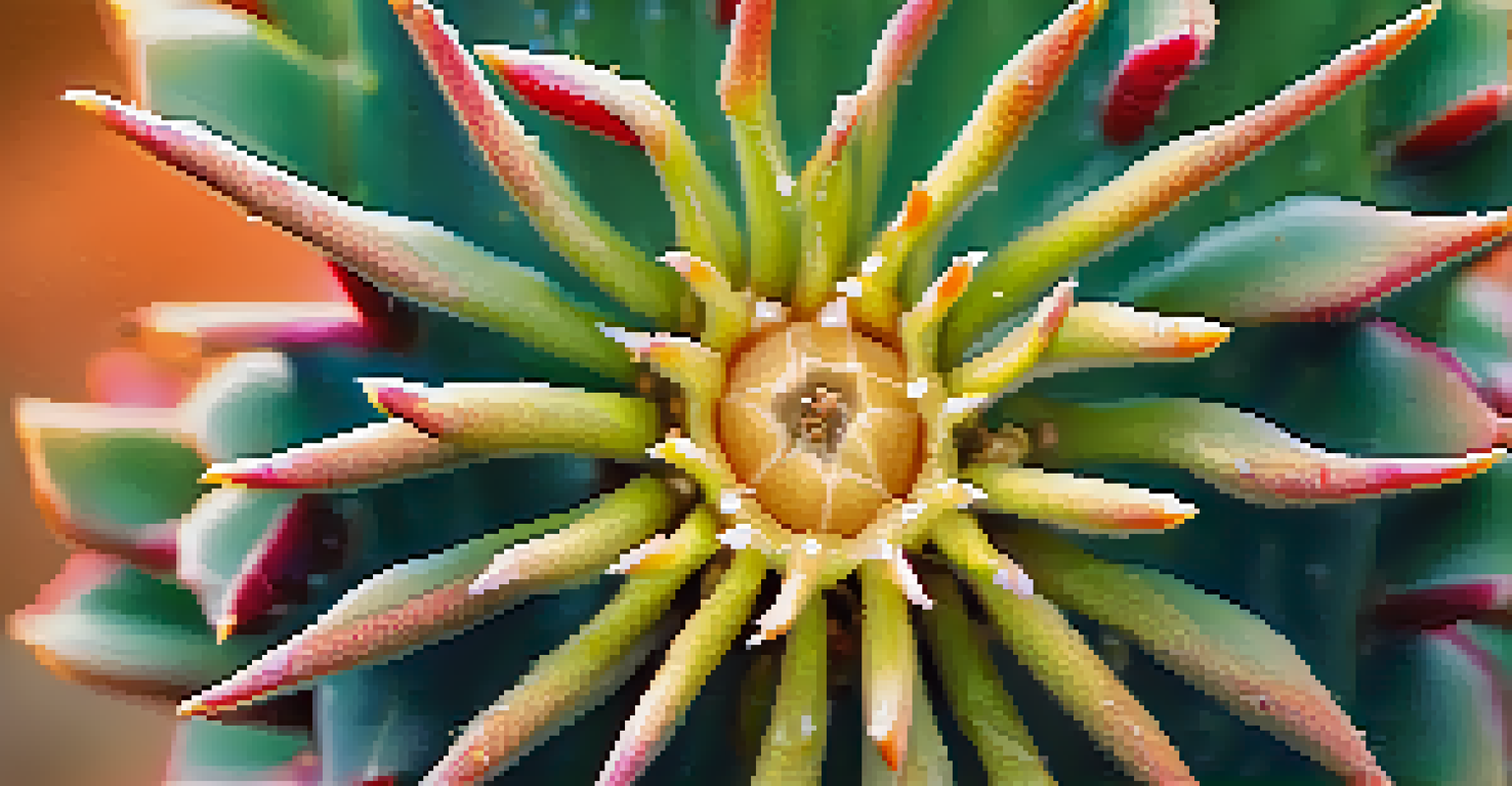Cultural Narratives: Stories Surrounding Peyote Use

Understanding Peyote: A Brief Overview
Peyote is a small, spineless cactus native to Mexico and the southern United States, famous for its psychoactive properties. This plant contains mescaline, a compound that induces altered states of consciousness. For many indigenous peoples, peyote is not just a plant but a sacred entity that plays a vital role in their spiritual practices and traditions.
Psychedelics can help us discover the depths of our own consciousness and understand our place in the cosmos, but we must approach them with reverence and respect for the traditions that birthed them.
Historically, peyote has been used in various ceremonial contexts, particularly among Native American tribes. The rituals surrounding its consumption often involve deep spiritual significance, emphasizing connection to nature and the divine. This cultural context is essential for understanding how peyote is viewed beyond its psychoactive effects.
In contemporary society, peyote is often viewed through the lens of recreational drug use, which can overshadow its cultural importance. By recognizing its historical and spiritual significance, we can appreciate the narratives that surround peyote and the communities that hold these stories close.
The Role of Peyote in Native American Spirituality
For many Native American tribes, peyote is integral to their spiritual rituals and healing practices. It is often used in ceremonies, such as the Native American Church, which blends Christian and indigenous beliefs. These gatherings provide a space for communal healing and spiritual connection, where peyote serves as a sacrament.

During these ceremonies, participants often share personal stories and insights gained through their peyote experiences. This sharing not only strengthens bonds within the community but also reinforces the spiritual teachings that peyote embodies. It’s a way of passing down wisdom through generations, preserving cultural narratives.
Peyote's Cultural Significance
Peyote serves as a sacred entity in indigenous cultures, playing a vital role in spiritual practices and community healing.
Moreover, the use of peyote in these rituals underscores a broader philosophy of respect for nature and the interconnectedness of all life. By consuming peyote, participants affirm their relationship with the earth and its gifts, turning a personal experience into a collective journey of spirituality and healing.
Peyote and Cultural Identity Among Indigenous Peoples
Peyote is more than just a plant; it symbolizes cultural identity for many indigenous communities. The practice of using peyote connects individuals to their heritage and traditions, fostering a sense of belonging. This cultural narrative is vital, especially in an era where indigenous identities face challenges from globalization and cultural erosion.
Cultural appropriation happens when the dominant culture takes elements from a marginalized culture without understanding or respecting their significance.
Incorporating peyote into cultural rituals helps to preserve languages, traditions, and stories that might otherwise fade away. When people engage with peyote in a ceremonial context, they are not only participating in a spiritual journey but also affirming their cultural identity. It's a powerful reminder of the importance of maintaining cultural roots.
The narratives surrounding peyote use often highlight resilience and the ongoing struggle for recognition and rights among indigenous peoples. These stories inspire solidarity and awareness, encouraging broader society to engage with and respect the cultural practices of these communities.
The Legal Landscape Surrounding Peyote Use
The legal status of peyote varies across different regions, often leading to confusion and controversy. While peyote is illegal in many places due to its psychoactive properties, exceptions exist for religious use among Native American tribes. This legal framework highlights the tension between cultural practices and governmental regulations.
In the United States, the American Indian Religious Freedom Act protects the rights of indigenous peoples to use peyote in their spiritual practices. However, this protection does not extend universally, creating disparities and debates over enforcement. Understanding these legal nuances is crucial for appreciating the broader cultural narratives surrounding peyote.
Legal Challenges for Peyote Use
The legal status of peyote varies, creating a complex landscape where indigenous rights are often at odds with broader drug regulations.
As society continues to grapple with issues of drug policy and religious freedom, the conversation around peyote remains relevant. Advocating for the rights of indigenous peoples to use peyote can help bridge the gap between cultural preservation and modern legal frameworks.
Peyote in Modern Spiritual Movements
In recent years, there has been a growing interest in peyote outside of indigenous cultures, particularly within modern spiritual movements. Many people seek peyote for its potential therapeutic benefits, including insights into mental health and emotional healing. This interest often leads to a complex dialogue about appropriation versus appreciation of indigenous practices.
While some individuals may genuinely seek to connect with the spiritual aspects of peyote use, others might overlook the cultural significance that comes with it. This raises important questions about who gets to access these sacred practices and how they should be respected. It’s essential to approach these topics with sensitivity and understanding.
As modern spiritual seekers navigate their journeys, learning from indigenous perspectives can enrich their experiences. By honoring the cultural narratives surrounding peyote, individuals can find a deeper connection to their spiritual paths while respecting the traditions of those who have used it for generations.
Personal Stories: Transformative Experiences with Peyote
Many individuals who participate in peyote ceremonies report transformative experiences that significantly impact their lives. These personal stories often highlight themes of healing, self-discovery, and profound connection with nature. Such narratives are powerful testaments to the potential of peyote as a tool for introspection and growth.
One common thread in these experiences is the sense of community that arises during ceremonies. Participants often share their journeys, fostering a supportive environment that encourages vulnerability and openness. This communal aspect of peyote use amplifies its effects, as individuals find strength in shared stories and experiences.
Modern Interest and Respect
Growing interest in peyote for therapeutic purposes raises important discussions about cultural appropriation and the need for respectful engagement.
These personal narratives are not just anecdotal; they serve as important cultural documentation, illustrating how peyote influences lives in diverse ways. By sharing their stories, individuals contribute to the broader tapestry of cultural narratives that surround peyote, ensuring that these experiences are recognized and valued.
The Future of Peyote Use and Cultural Narratives
As society evolves, the future of peyote use and its cultural narratives will undoubtedly continue to change. Ongoing discussions about drug policy, cultural appropriation, and indigenous rights play crucial roles in shaping how peyote is perceived and used. Understanding these dynamics is vital for fostering respectful engagement with peyote's cultural significance.
Moreover, the increasing interest in psychedelics for therapeutic use may lead to greater awareness of peyote and its traditional uses. This presents an opportunity for education and dialogue, emphasizing the importance of respecting indigenous practices while exploring potential benefits. However, it also requires vigilance to ensure that these practices are not commodified or exploited.

Ultimately, the future of peyote use lies in balancing respect for tradition with modern exploration. By honoring the cultural narratives that surround peyote, we can create a more inclusive conversation that values both indigenous wisdom and contemporary spiritual journeys.